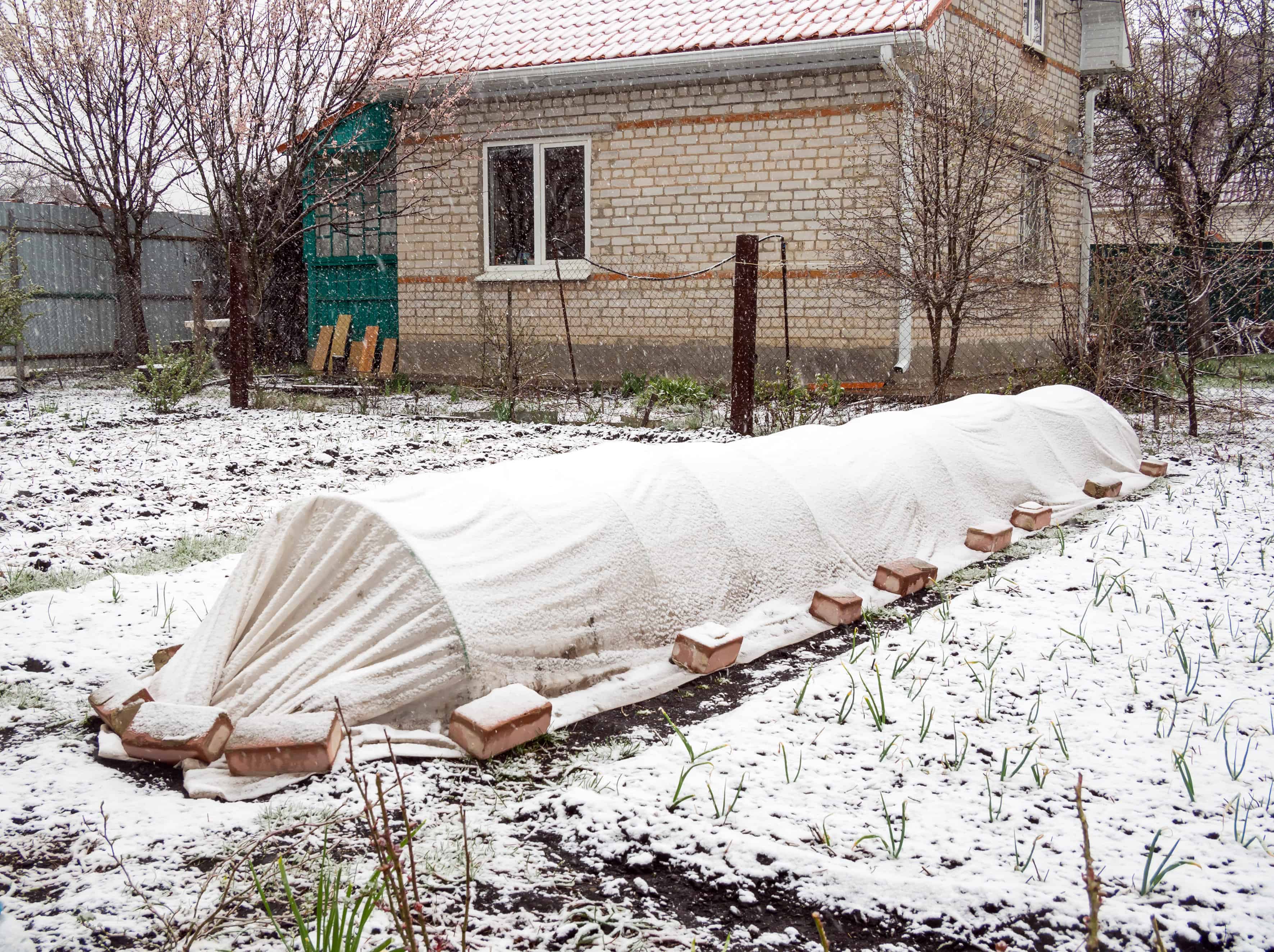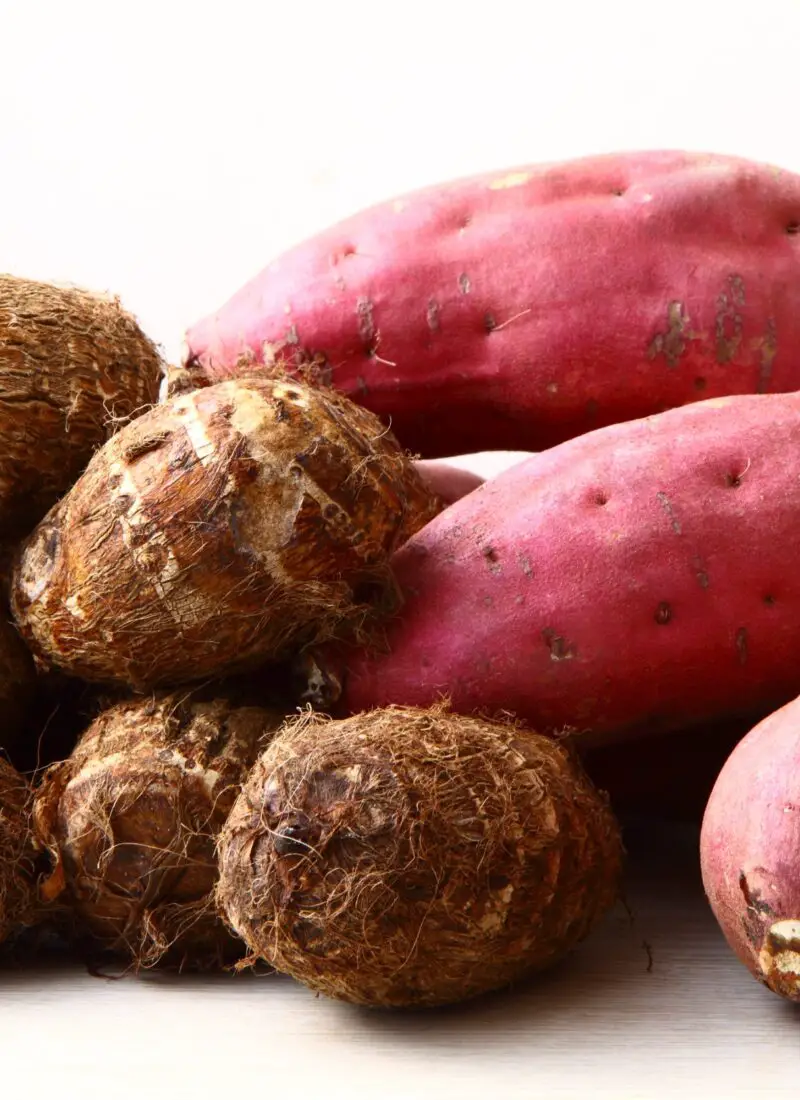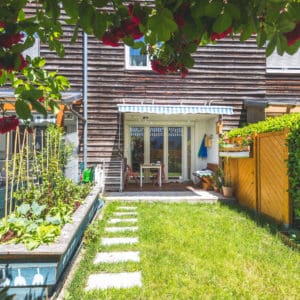
Winter is the time when everything hibernates and slows down, including your plants. But, what if you could keep plants growing in your food garden to harvest throughout winter?
As a whole, it is possible to grow plants in food gardens during winter. It requires planting cold-hardy plants in late fall and using season extenders such as cold frames, hot beds, cloches, mulch, low tunnels, and unheated greenhouses. These tools help to insulate and protect the crops from frost.
Have a read below as I elaborate on winter gardening, plants to grow, and tips to maintain your food garden in winter.
(As an Amazon Associate, I earn from qualifying purchases.)
Table of contents
How Is It Possible to Garden in the Winter?

First, growing a garden in the winter is much easier when you use cool-season vegetables as they do best in cold and damp conditions. Then cloches, low tunnels, cold frames, and/or an unheated greenhouse can be used to insulate the plants and protect them from frost and temperature drops. By pairing cold-season vegetables with these methods, we can stretch the plant’s growth cycle and allow a continual harvest throughout the winter.
Plants generally go dormant during winter, slowing down their growth, so don’t be alarmed if the plants aren’t growing as fast as your spring batch. Also, note that zones 1-3, where temperatures dip to below the freezing point, may require additional help to make the garden grow. In these zones, you can install insulation to maintain warm temperatures and provide grow lights for the plants’ light needs to overwinter your food garden.
What is Winter Gardening?

There are several methods of winter gardening:
- Planting cool-season vegetables in early spring. The cool temperatures of early spring make it an appropriate time to plant quick maturing crops and harvest before the season turns warmer. Allowing these plants to grow further in the summer will affect the taste and quality of the high temperature. For example, lettuces will start ‘bolting’ (i.e., begin to flower and produce seeds) and taste bitter if not harvested in time. Examples of these quick maturing crops are:
- Lettuce
- Spinach
- Arugula
- Watercress
- Sorrel
- Mustard Greens
- Bok Choy
- Planting cool-season vegetables in late fall and harvesting during winter. Like early spring plantings, growing quick to average maturing crops in late fall will give you an early harvest. The advantage here is that the plants will stay fresh during the winter as growth slows down, provided there is a reasonably-sized harvest already. However, be sure to add a layer or two of protection to prevent the frost from destroying the crops. Examples of these quick to average maturing crops are:
- Kale
- Kohlrabi
- Lettuce
- Radish
- Turnips
- Collards
- Chard
- Leeks
- Planting cool-season vegetables/herbs during winter. It is possible to plant winter-hardy seeds in the ground provided the soil isn’t frozen. The seeds will remain frozen throughout winter and only start sprouting when the temperature changes in spring. Alternatively, seeds wrapped in damp tissue paper and placed in a closed tupperware with drain holes can be left outside during winter to germinate. The containers act like mini-greenhouses, protecting the seeds from severe frost. In both cases, the hardy seeds require cold and damp conditions to soften the hard shells, allowing tender shoots and roots to sprout out and be ready by spring. This process of seed germination is called cold stratification and is widely practiced as winter sowing. Examples of hardy seeds you can plant in winter are (including the previously mentioned vegetables above):
- Lavender
- Chamomile
- Mache
- Beets
- Cabbages
- Carrots
- Calendula
- Alyssum
- Planting cool-season vegetables in late fall to harvest in early spring. Planting slow-maturing crops in late fall allows the plants to go dormant in winter, sweetening the crops. This phenomenon is called Winter Sweetening. The starch in the vegetables is converted to sugar to prevent the plants from freezing, improving the taste. However, it’s crucial to provide a layer or two of protection to the plants to avoid damage. Examples of slow-maturing crops are:
- Beets
- Carrots
- Onions
- Cabbages
- Parsnips
- Brussel sprouts
You’ll notice I’ve only mentioned cool-season vegetables/herbs so far in these methods. It is intentional because warm-season vegetables are generally very tender plants easily damaged or destroyed by frost. Some can handle cool temperatures like snap beans and sweet corn; most do not. For example, cucumbers go bitter when exposed to cold temperatures.
However, warm-season plants can be started indoors to germinate, provided they receive ample light from LED grow lights and are kept warm using heating mats. This gives you a headstart so that once spring arrives, the seedlings are ready to go into the ground. Here are a few things on Amazon to help you get started:
- Seedling Heat Mat with 3,392 ratings and an average 4.6 stars.
- BLOOM PLUS LED Grow Light with 3,487 ratings and an average of 4.5 stars.
Fruits, in general, need warm temperatures to grow, take root, and pollinate, even cool climate fruits. They are usually ready for harvest by late fall to early winter, but that doesn’t mean they continue growing when the branches are laden with frost. Like most perennial plants, they go into a dormant stage until spring comes.
What Can I Grow in My Garden in Winter?



| Vegetables (Leaf Crops) | Vegetables (Root Crops) | Herbs |
| Lettuce | Carrots | Parsley |
| Spinach | Parsnips | Mint |
| Kohlrabi | Beets | Thyme |
| Asparagus | Radishes | Sage |
| Cabbage | Turnips | Oregano |
| Swiss Chard | Garlic | Chives |
| Bok Choy | Onion | Lemon Balm |
| Leeks | Rutabagas | Tarragon |
| Scallions | – | – |
| Kale | – | – |
| Peas | – | – |
| Arugula | – | – |
| Brussel Sprouts | – | – |
Note: This is a general list of cold-hardy crops you can grow in winter. Planting and harvest success may vary depending on your state’s hardiness zone. Check accordingly when choosing plants you want to include in your winter garden.
How Do I Maintain My Food Garden in Winter?

As a whole, winter gardens are maintained by ensuring the plants’ water, light, and air circulation needs are met as with any other plant. Except these are done in fewer quantities compared to in spring and summer. But, the most vital thing to remember is never to fertilize your food garden in winter. The plants won’t have the energy to absorb the added nutrients, which can be detrimental to their roots. The roots may end up “burned” if exposed to too much excess fertilizer for too long, depending on how much of the root system is burned, the plant may even die.
How often should I water my plants in winter?
You should water plants once a week during winter. Typically, winter gardens need less watering than in other seasons because the protective coverings help the soil and plants retain moisture far longer than is typical in summer months. However, always check the soil by dipping your fingers 1-2 inches deep to observe whether it is damp or dry. If it is dry, water your plants; if it is damp, hold off on watering and check again in 2 days.
Should I feed my garden plants in winter?
This may seem repetitive, but it is important!! You should never feed your plants in the winter. Again, giving fertilizers to plants during their dormant state in the cold season will cause their roots to ‘burn’ and kill them. Feeding the plants in late fall is safer and beneficial to boost their root and foliage growth before the ground freezes.
Use a water-based solution or diluted liquid fertilizer to feed your food garden according to the label’s instructions and use the recommended intake. I highly recommend using organic fertilizers as these are more environmentally friendly long term.
Should I provide grow lights for my plants in winter?
For those residing in state hardiness zones 1-3, including grow lights in your winter food gardens is recommended. But it is entirely optional for other state hardiness zones. There is often just enough sunlight to get by since the plants are in a dormant state anyway.
It is advisable for those in zones 1-3 to plant edible gardens indoors with LED grow lights to supplement the plants’ light needs. This practice also applies to germinating seeds indoors for those wanting to get a headstart in preparing their plants for the next planting season, from spring to summer.
A helpful tip is to place the grow lights near the plants to increase the light intensity. Keep the grow lights switched on for 14-20 hours daily, particularly for sun-loving plants, to keep them happy through the miserable winter. Sounds a little too relatable, to be honest.
How do I ensure good air circulation for my garden in winter?
On sunny or warm days, open up the protective coverings like cold frames, cloches, low tunnels, hot beds, and unheated greenhouses to allow air to flow in and out of the garden. This manual ventilation ensures good air circulation in winter gardens. Row covers and mulches are an exception because they have self-ventilating features to keep the plants not too hot and not too cold, just right like a baby bear’s porridge.
How do I protect my plants in the winter?

- Row covers/Low tunnels. These items keep the area around the plants warm by weighing and securing the plastic or fabric cover material down on the ground. A floating row cover is supported by sturdy crops or structures in the garden bed; a low tunnel uses semi-circle hoops to suspend the cover over the crops. It is best to use thick and heavyweight row covers/low tunnels to protect your plants from frost. Note: Row covers are better paired with mulch.
Helpful tips: Plastic cover material will retain more heat than a fabric one. However, ensure to remove the row cover/low tunnel on warm days so the plants don’t die from the internal heat. Fabric cover materials are self-ventilating and semi-permeable to allow water in. The thicker it is, the better frost protection it can provide. Though, ensure it doesn’t weigh the crops down. This Row Cover on Amazon is a particularly good one to use.

- Cloches. These are bell or dome-shaped covers usually made of glass or plastic to protect individual plants. Yes, it does mean you’ll have to buy several for your many plants but I find that reserving cloches for seedlings only is more reasonable. A closed cloche is particularly great for frost protection, but it traps more heat during sunny days. Opening it up for a few minutes every day is recommended to ventilate the plant. But you can also get ones with vents, like these Garden Cloches on Amazon. Alternatively, you can cut up plastic bottles or milk jugs to create a makeshift cloche! Just make sure to secure it tightly into the soil and weigh it down with a heavy object, so the wind doesn’t blow it down. Note: Cloches are better paired with mulch.

- Cold frames/Hot beds. A cold frame is a raised container box with a hinged, sliding, or clear lid to keep the garden insulated from the cold weather. When added with a heating device like electric lights, it becomes a hot bed. It’s as simple as stringing up fairy lights inside the box. [Disclaimer: Fairies were not harmed in the making of these lights]. Although, this is only recommended if the outside temperature is particularly nippy. Cold frames are usually bought as-is or as an easy lid setup for your garden. If you’re a hardcore DIYer, you can undoubtedly construct one of your own. Ensure to pop the lid open for a few minutes daily for ventilation.

- Polytunnels. Also known as a ‘hoop house’, this item combines the concept of a low tunnel and a greenhouse, which means it is large enough to walk in and cover your whole crop. It’s also less costly than a greenhouse and, in some cases, even portable! It uses hoops to support the extensive plastic cover with the sides secured with weights like a low tunnel. Make sure to open up the entrance during warm days for ventilation. Note: Polytunnels are best paired with mulch and cloches.

- Unheated greenhouse. This is more of a permanent structure in your yard intended for all-year-long gardening, not just for the winter. A heated greenhouse functions to hold heat during the day and lose it when the temperature drops at night. With an unheated greenhouse, though, the internal temperature on cold nights will be similar inside the structure but still protect your crops from frost. I only recommend getting a greenhouse if you have a large food garden to tend to yearly. Note: Unheated greenhouse is best paired with row covers, cloches, and mulch.

- Mulch. This substance is primarily used to retain moisture, suppress weeds, and prevent freezing in the soil. It could be made of inorganic material which won’t decompose or organic material which will break down and replenish the soil with nutrients. It is common for gardeners to use black plastic as mulch and cover the ground around their crops. It traps heat really well, which makes overheating a problem for the plants during sunny days in winter. There is the option of using clear plastic mulch, but unfortunately, this doesn’t hinder weeds from sprouting. You can also use organic mulch like shredded leaves, newspapers, straw, or grass clippings. But take note that these will decompose, get soggy, and kind of nasty when the temperature warms up. Note: Mulch is best paired with row covers/low tunnels, cloches, polytunnels, and an unheated greenhouse.
When installing these protective layers, a good rule of thumb is to first start with the bare minimum of protection. Mulch is an excellent base to begin with, then you can add on row covers or cloches from there. Some hardy leaf crops won’t mind light frost on them, but the rest would find offense and dramatically perish on you for leaving them out in the cold. So don’t panic if some do get slightly damaged. Employ an additional protective layer and observe if that is enough. Some people can survive on one blanket, but others need multiple layers of clothing, a quilt, and a fireplace to keep warm, and even then, their teeth are still chattering, plants are like that too.
Final Words
Winter gardening is not as impossible as you might think. So with a little bit of adjustment and creativeness on your part you can help your food garden continue to flourish even in the cold climate. Winter can be boring for a gardening addict, keep yourself busy and still put fresh produce on your dinner table
References:
https://extension.psu.edu/season-extenders-and-growing-fall-vegetables
https://www.foodandwine.com/lifestyle/winter-gardening-yes-it-possible-and-heres-how
https://getbusygardening.com/winter-sowing-seeds/#when-to-start
https://www.thespruce.com/what-is-winter-sowing-1403095
https://extension.illinois.edu/blogs/good-growing/2020-03-27-starting-garden-warm-season-vegetables
https://www.gardeningknowhow.com/edible/herbs/hgen/herbs-that-survive-winter.htm
https://www.canr.msu.edu/news/row_covers_for_frost_protection_and_earliness_in_vegetable_production
https://extension.uga.edu/publications/detail.html?number=C1027-14
https://lee.ces.ncsu.edu/2017/01/extending-the-season/
https://caswell.ces.ncsu.edu/2020/06/what-is-a-high-tunnel/
https://extension.unh.edu/resource/very-small-greenhouses-back-yards
https://www.canr.msu.edu/news/smart_vegetable_gardening_with_season_extenders







Leave a Reply